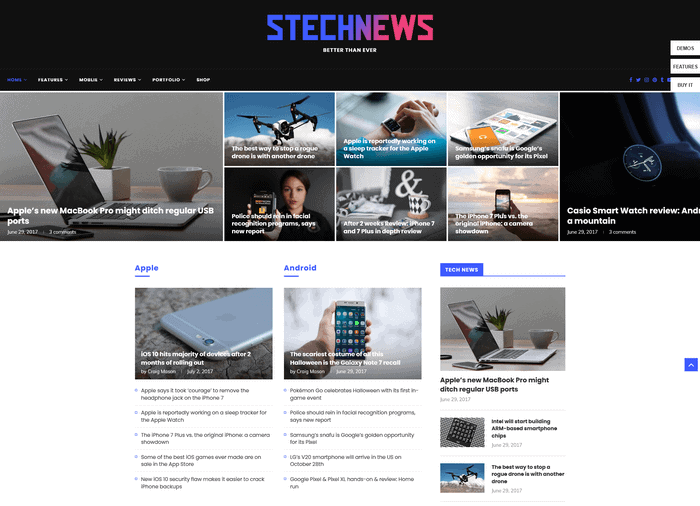Discover the Best tech blog for the current Trends and Developments in Innovation
Discover the Best tech blog for the current Trends and Developments in Innovation
Blog Article
Recognizing the Increase of Side Computer in Today's Digital World
In the quickly progressing landscape of technology, edge computing emerges as a crucial pressure, improving exactly how data is refined and made use of. This paradigm shift is driven by the spreading of IoT gadgets and a rising need for rapid data processing. By transitioning data monitoring closer to the resource, edge computer addresses crucial latency issues while maximizing transmission capacity usage and improving safety and security measures. As sectors pivot in the direction of smarter, much more effective systems, understanding the subtleties and ramifications of this technological advancement comes to be essential. What does this mean for future innovations and the electronic environment overall?
What Is Edge Computer
Edge computer, although a relatively current development in the world of modern technology, essentially transforms exactly how information is refined and taken care of by bringing computation and data storage space closer to the location where it is needed. Unlike typical cloud computer models, which commonly depend on central information centers that can be geographically far-off, side computer decentralizes information handling. This proximity minimizes latency, boosts real-time data processing, and enhances the total user experience by making certain faster action times.
At its core, side computing entails a network of localized gadgets and infrastructure, such as routers, sensors, and gateways, efficient in refining information at or near the resource. This local handling capability is especially crucial for applications needing instant information analysis, such as self-governing automobiles, commercial automation, and clever cities. Additionally, by unloading data processing tasks from main web servers, edge computing reduces data transfer demands and improves data personal privacy and security, as delicate details can continue to be on-site as opposed to traversing comprehensive networks.

Key Drivers of Fostering
A number of variables are moving the fostering of side computer in today's digital landscape. Edge calculating addresses this demand by enabling data handling closer to the data resource, lowering latency and boosting real-time decision-making abilities.
An additional significant driver is the need for enhanced bandwidth efficiency. Centralized cloud systems can come to be overloaded with the large volume of data created by IoT gadgets, causing bottlenecks (Best tech blog). By processing information at the edge, organizations can minimize network blockage and enhance total system efficiency
Moreover, security and privacy concerns are pushing companies towards edge computing. By processing sensitive data in your area, firms can minimize risks connected with information transmission and direct exposure to possible cyber threats.
The rise of applications requiring real-time handling, such as independent automobiles and increased truth, likewise necessitates the rapid response times that border calculating offers. Collectively, these drivers are making side calculating an indispensable part of modern IT infrastructure, leading the way for its widespread fostering throughout various sectors.
Benefits Over Cloud Computing
Exactly how does side computing identify itself from conventional cloud computer? Primarily, side computer brings information processing closer to the resource of data generation, often on neighborhood gadgets or neighboring servers, rather than relying on centralized information.
Moreover, edge computing enhances data transfer efficiency (Best tech blog). By processing information locally, just the necessary data is transmitted to the cloud for more evaluation or storage space, decreasing the quantity of data that passes through the network. This not only relieves network blockage however likewise reduces data transmission expenses
Edge computing additionally offers enhanced information privacy and security. Sensitive data can be refined locally without being sent out to the cloud, lessening the exposure to prospective cyber risks. This is particularly useful for industries handling secret information, such as medical care and economic services.
Furthermore, side computing ensures better durability and dependability. Local handling enables for proceeded procedure even when connectivity to the cloud is compromised, preserving vital functions and services despite potential network disruptions. These advantages collectively demonstrate edge computer's transformative capacity in maximizing performance and safety and security in electronic ecological communities.
Considerations and challenges
While side computer uses many advantages, it also presents one-of-a-kind difficulties and considerations that should be dealt with to completely recognize its possibility. One substantial challenge is information security and personal privacy. Handling information more see this website detailed to the source increases the danger of unapproved access, requiring durable encryption and rigid security protocols to secure sensitive info. In addition, handling and keeping an eye read the full info here on a decentralized network of side gadgets can be intricate, calling for innovative devices and methods to make certain smooth procedure and upkeep.
One more factor to consider is the scalability of side computing options. As the variety of linked devices grows, so does the demand for refining power at the side, which can lead to source restraints. Organizations should very carefully prepare their infrastructure to suit this development without jeopardizing efficiency or performance.
Interoperability is another essential variable. With numerous equipment and software application components involved, making certain compatibility and smooth combination can be challenging. Standardization efforts are necessary to promote interaction between inconsonant systems.
Future Patterns in Edge Computer
Expecting the future, side computing is positioned to revolutionize different sectors by enabling quicker information processing and decreasing latency. As the quantity of information created by IoT devices proceeds to expand, side computing will end up being significantly vital in handling this increase successfully.
One more emerging pattern is the growth of edge-native applications designed specifically to utilize the distinct capacities of side computing. These applications will maximize performance and resource usage, leading to enhanced performance throughout various markets. Additionally, advancements in 5G technology will additionally boost edge computing by giving the necessary infrastructure for high-speed, low-latency interaction in between tools and side nodes.
Conclusion
Edge computing's rise is driven by the expansion of IoT devices and the requirement for real-time information handling, which boosts performance by decreasing latency and decentralizing data management. This approach minimizes data transfer inadequacies and safety and security issues, facilitating innovations in applications like independent lorries and smart cities. Despite obstacles such as framework complexity and integration, the future of side computer promises an extra receptive digital community, with continued technologies forming its evolution and expanding its applicability throughout industries.
Side computer, although a relatively current advancement in the world of modern technology, basically transforms exactly how data is processed and handled by bringing calculation and information storage space closer to the area where it is required. Unlike standard cloud computing models, which frequently count on centralized data facilities that can be geographically remote, edge computer decentralizes data handling. In addition, by offloading information handling tasks from main servers, edge computer reduces transmission capacity demands and boosts data personal privacy and safety and security, as delicate information can stay on-site instead than traversing considerable networks.

Report this page